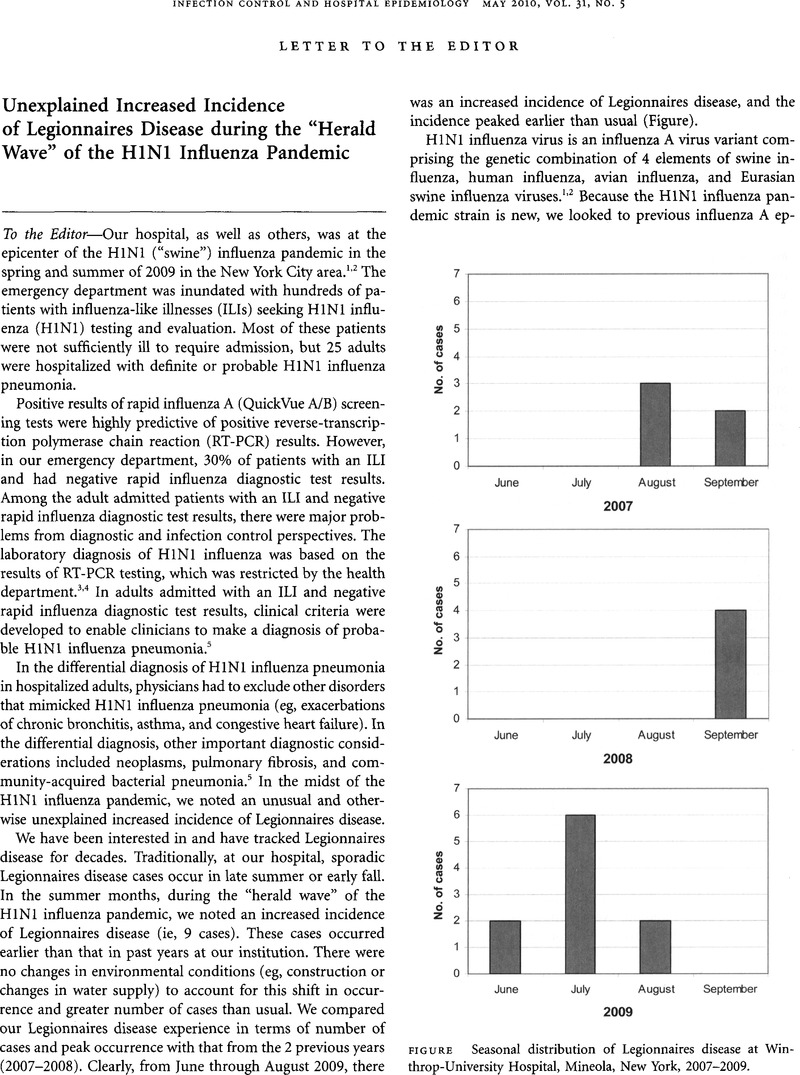Crossref Citations
This article has been cited by the following publications. This list is generated based on data provided by Crossref.
Cunha, B. A.
Strollo, S.
and
Schoch, P.
2010.
Extremely elevated erythrocyte sedimentation rates (ESRs) in Legionnaires’ disease.
European Journal of Clinical Microbiology & Infectious Diseases,
Vol. 29,
Issue. 12,
p.
1567.
Cunha, Burke A.
2010.
Legionnaires' Disease: Clinical Differentiation from Typical and Other Atypical Pneumonias.
Infectious Disease Clinics of North America,
Vol. 24,
Issue. 1,
p.
73.
Cunha, Burke A.
Mickail, Nardeen
Syed, Uzma
Strollo, Stephanie
and
Laguerre, Marianne
2010.
Rapid clinical diagnosis of Legionnaires' disease during the “herald wave” of the swine influenza (H1N1) pandemic: The Legionnaires' disease triad.
Heart & Lung,
Vol. 39,
Issue. 3,
p.
249.
Cunha, Burke A.
Klein, Natalie C.
Strollo, Stephanie
Syed, Uzma
Mickail, Nardeen
and
Laguerre, Marianne
2010.
Legionnaires' disease mimicking swine influenza (H1N1) pneumonia during the “herald wave” of the pandemic.
Heart & Lung,
Vol. 39,
Issue. 3,
p.
242.
Cunha, Burke A.
Pherez, Francisco M.
Strollo, Stephanie
Syed, Uzma
and
Laguerre, Marianne
2011.
Severe swine influenza A (H1N1) versus severe human seasonal influenza A (H3N2): Clinical comparisons.
Heart & Lung,
Vol. 40,
Issue. 3,
p.
257.
Cunha, Burke A.
Corbett, Michael
and
Mickail, Nardeen
2011.
Human parainfluenza virus type 3 (HPIV 3) viral community-acquired pneumonia (CAP) mimicking swine influenza (H1N1) during the swine flu pandemic.
Heart & Lung,
Vol. 40,
Issue. 1,
p.
76.
Cunha, Burke A.
Mickail, Nardeen
and
Schoch, Paul
2011.
Human parainfluenza virus type 3 (HPIV 3) community-acquired pneumonia (CAP) mimicking pertussis in an adult: The diagnostic importance of hoarseness and monocytosis.
Heart & Lung,
Vol. 40,
Issue. 6,
p.
569.
Cunha, Burke A.
Syed, Uzma
and
Mickail, Nardeen
2011.
Systemic lupus erythematosus (SLE) pneumonitis mimicking swine influenza pneumonia during the swine influenza (H1N1) pandemic.
Heart & Lung,
Vol. 40,
Issue. 5,
p.
462.
Cunha, Burke A.
Syed, Uzma
and
Hage, Jean E.
2012.
Respiratory syncytial virus (RSV) community-acquired pneumonia (CAP) in a hospitalized adult with human immunodeficiency virus (HIV) mimicking influenza A and Pneumocystis (carinii) jiroveci pneumonia (PCP).
Heart & Lung,
Vol. 41,
Issue. 1,
p.
76.
Cunha, Burke A.
2013.
In hospitalized adults the combined presence of leukocytosis, relative lymphopenia, and thrombocytopenia is predictive of swine influenza (H1N1).
Journal of Infection,
Vol. 67,
Issue. 5,
p.
489.
Cunha, B.A.
Connolly, J.
and
Abruzzo, E.
2015.
Increase in pre-seasonal community-acquired Legionnaire's disease due to increased precipitation.
Clinical Microbiology and Infection,
Vol. 21,
Issue. 6,
p.
e45.
Cunha, Burke A.
and
Raza, Muhammad
2015.
During Influenza Season: All Influenza-Like Illnesses Are Not Due to Influenza: Dengue Mimicking Influenza.
The Journal of Emergency Medicine,
Vol. 48,
Issue. 5,
p.
e117.
Cunha, B. A.
Connolly, J. J.
and
Irshad, N.
2016.
The clinical usefulness of lymphocyte:monocyte ratios in differentiating influenza from viral non-influenza-like illnesses in hospitalized adults during the 2015 influenza A (H3N2) epidemic: the uniqueness of HPIV-3 mimicking influenza A.
European Journal of Clinical Microbiology & Infectious Diseases,
Vol. 35,
Issue. 1,
p.
155.
Cunha, Burke A.
and
Cunha, Cheston B.
2017.
Legionnaire’s Disease and its Mimics.
Infectious Disease Clinics of North America,
Vol. 31,
Issue. 1,
p.
95.



